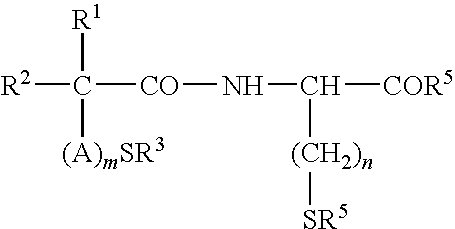Treatment and Prevention of Skin Injury Due to Exposure to Ultraviolet Light
a technology of ultraviolet light and skin injury, applied in the field of treatment or prevention of skin injury due to ultraviolet light, to achieve the effect of preventing skin damag
- Summary
- Abstract
- Description
- Claims
- Application Information
AI Technical Summary
Benefits of technology
Problems solved by technology
Method used
Image
Examples
example 1
Assays with Bucillamine—a Representative N-mercaptoalkanoylcysteine
[0096]In order to assess any adverse effects of bucillamine and UV exposure separately, a preliminary experiment was carried out in which SKH-1 mice were either treated with bucillamine (20 mg / kg s.c.) or UVB (230 mJ / cm2) irradiation. Bucillamine can, for example, be administered intravenously, subcutaneously, intramuscularly or orally. Subcutaneous administration was used because it is a relatively easy route and the least likely to injure the animal during administration. The selection of bucillamine dose and UVB dose was based on previously published studies (13, 19, 21, 22). High dose of UVB (230 mJ / cm2) was selected to investigate bucillamine effect on acute photodamage. Each group of animals received two doses of bucillamine or UVB, 24 hours apart. Bucillamine was found to have no adverse effects in such experiments. UVB exposure caused edema, erythema and thickening of the exposed skin. Therefore the dose of b...
example 2
Effects of Bucillamine on Histology in UV-Exposed Skin
[0097]UVB exposure induced mild edema, erythema and thickening of the dorsal skin in untreated SKH-1 mice, while bucillamine pre-treatment attenuated the erythema. UV-exposed skin in untreated mice showed scattered necrotic epidermal keratinocytes, papillary dermal edema and dermal infiltration of leukocytes at 6 hours after the last UVB exposure. In bucillamine pre-treated mice there were similar abnormalities at 6 hours after the last UVB exposure, but the epidermal necrosis was less prominent. At 24 hours after the last UVB exposure, UV-exposed skin in untreated mice showed hyperkeratosis and acanthosis (thickening of the epidermis) in the epidermis and papillary dermal edema, infiltration of leukocytes and dilated blood vessels in the dermis. In contrast, bucillamine pre-treatment attenuated the UV-effects on inflammation (dermal edema, leukocyte infiltration and dilatation of blood vessels) at 24 hours after the last UVB exp...
example 3
Materials and Methods for Examples 1 and 2
[0114]Chemicals and Reagents. Powdered bucillamine (>99% purity) was obtained from Keystone Biomedical, Inc. (Los Angeles, Calif.). Stock solutions of bucillamine (10 mg / ml) were made in normal saline, pH adjusted to approximately 7.4 with equimolar NaOH, and filter sterilized before injecting into the animals. Anti-actin (mouse monoclonal) was purchased from Sigma (St. Louis, Mo.). Anti-p53 (rabbit polyclonal) was obtained from Novocastra (UK). Phospho-p53 (ser15) and phospho-p53 (ser20) antibodies were from Cell Signaling Technology (Danvers, Mass.). Anti-ubiquitin antibody was a rabbit polyclonal from Sigma (St. Louis, Mo.), while anti-PUMA rabbit polyclonal was purchased from Cell Signaling (Danvers, Mass.). Horseradish peroxidase-conjugated secondary antibodies were purchased from Jackson Immuno Research Laboratories, Inc. (West Grove, Pa.). Complete Mini (protease inhibitor cocktail tablets, cat #11 836 153 001) was obtained from Roche...
PUM
| Property | Measurement | Unit |
|---|---|---|
| Pharmaceutically acceptable | aaaaa | aaaaa |
| Exposure limit | aaaaa | aaaaa |
Abstract
Description
Claims
Application Information
 Login to View More
Login to View More - R&D Engineer
- R&D Manager
- IP Professional
- Industry Leading Data Capabilities
- Powerful AI technology
- Patent DNA Extraction
Browse by: Latest US Patents, China's latest patents, Technical Efficacy Thesaurus, Application Domain, Technology Topic, Popular Technical Reports.
© 2024 PatSnap. All rights reserved.Legal|Privacy policy|Modern Slavery Act Transparency Statement|Sitemap|About US| Contact US: help@patsnap.com










